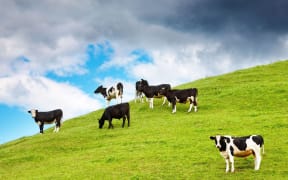Gloom is predicted for the dairy industry but other primary industry sectors are in for a bright year, a Rabobank report says.

Photo: RNZ / Rachel Graham
Rabobank has just released its outlook for agriculture in 2016, which says it will continue to be tough for dairy farmers, but good for beef and wool producers, the horticulture industry and wine makers.
Rabobank research analyst Emma Higgins said dairy prices were expected to pick up towards the end of 2016, but cash flows would remain tight for the rest of the year.
Beef prices had eased from record highs, but were expected to stay at strong levels because of demand.
"It comes down to the United States, they love a good beef pattie in their burgers and it's certainly this US demand that will help farm gate prices over here in New Zealand in 2016."
Cattle herd rebuilding in Australia after years of drought would mean less competition for lean beef into the US, which would help to support prices, she said.
Wool producers would face competition from cheap synthetic fibres, but that would be offset by declining production in New Zealand and Australia.
While the dry, hot conditions had not been welcomed by sheep and beef farmers, it would help the wine industry production this year, she said.
"Climatic conditions will help to underpin an increase in production and average prices have held up well. In addition to that there's been really good momentum for New Zealand product sales in the US and China, so the trend and consumer preference is positive for NZ wine as we see a shift towards higher priced wine and lighter styles."
Fruit exporters broke through the $2 billion mark for the first time last year, helped by record kiwifruit and apple crops, and strong demand for both fruits in Asia is expected to support high returns, she said.
But the glow of those industries would not outweigh the dairy downturn, which would continue to impact the regions and rural communities, she said.




